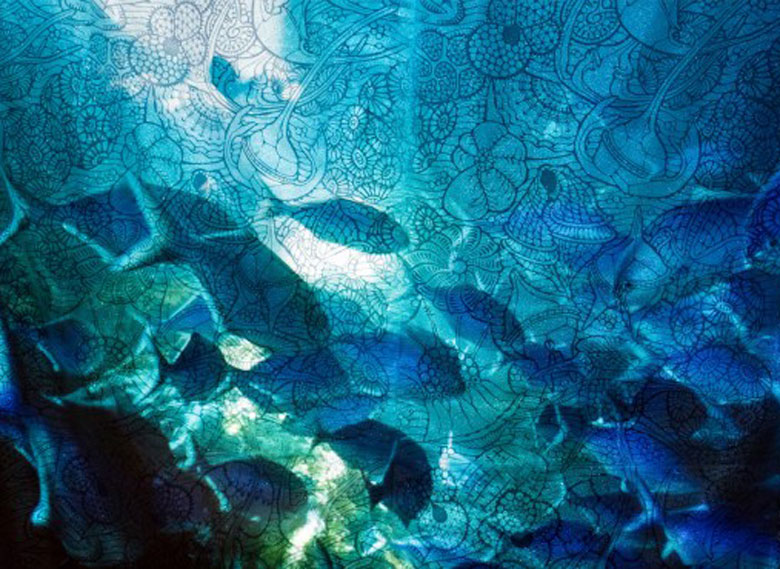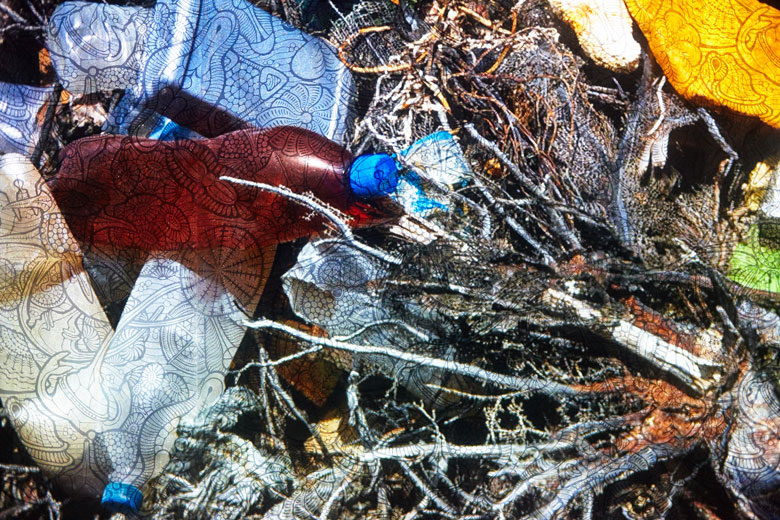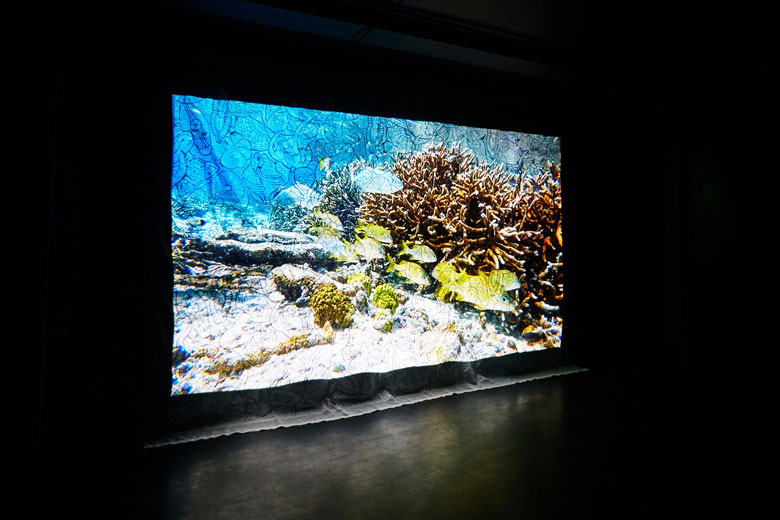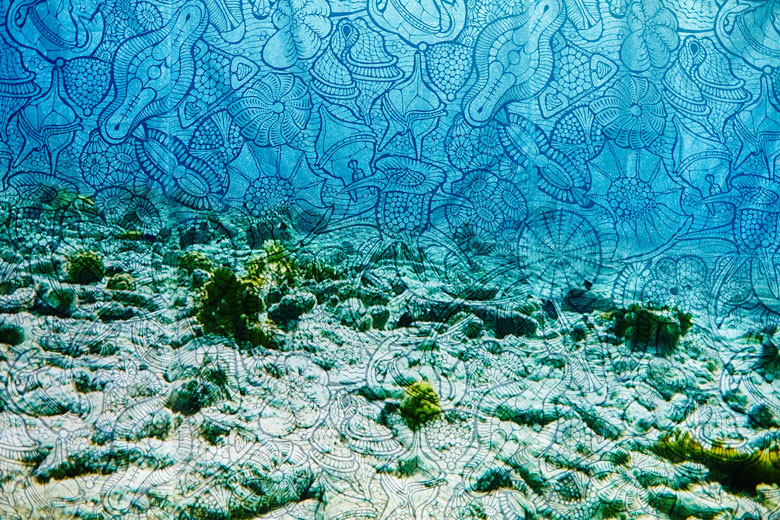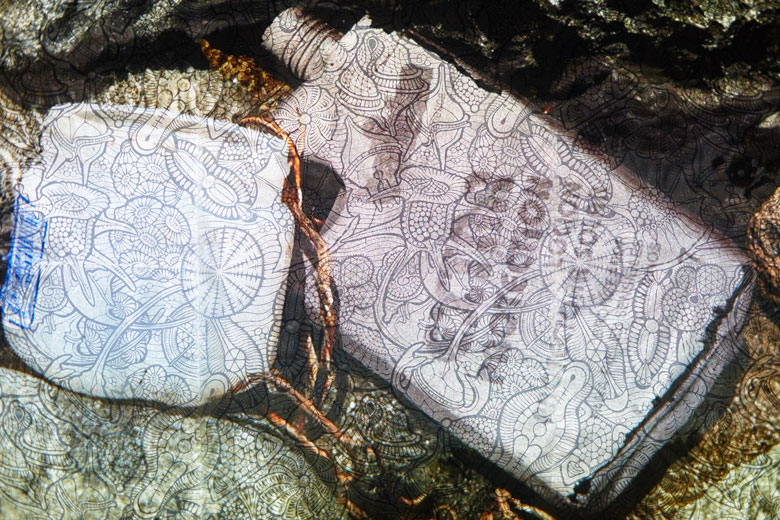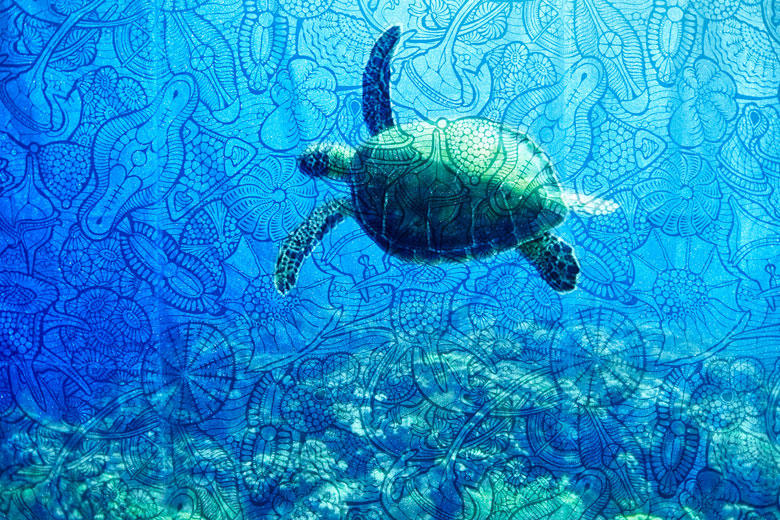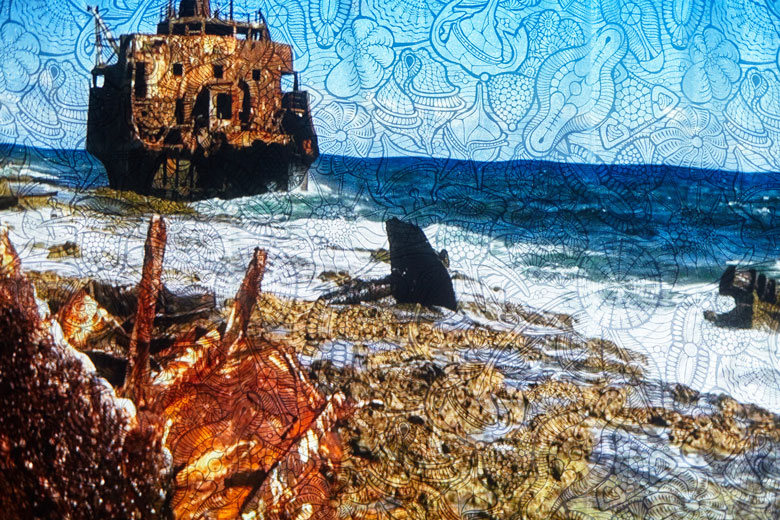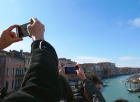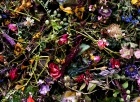A dark room, blue swirling waters, animated critters dancing across the screen.
In Eveline Kolijn’s The Ocean Inside (2019) images of plastic littered along the shore and the pallid remains of a devastated coral reef languish behind a quivering large-scale printed work on fabric. The printed projection veil, reminiscent of Enlightenment era botanical illustrations depicts various types of plankton found in the ocean surrounding Curaçao, a Dutch colony in the Caribbean. The film features voice overs in several different languages, reciting facts which, as one stands in the gallery, hang in the air, unverifiable. Some of them are poetic facts: “Every second breath we take comes from the ocean.” Others, a terrifying premonition: “Within thirty years, we may have more plastic than fish in the ocean.” Audiences can view this part documentary, part memorial for the reefs from two vantage points: from the front, where they can witness the catastrophic effects of pollution, human mistreatment, and climate change from a cool, scientific distance, and from behind the screen. When standing behind, the viewer is shrouded in the undulating, aquamarine tones of the oceanic footage, their body becoming implicated and integrated into Kolijn’s narrative. The project is the result of five years of the artist filming her childhood home in Curaçao, creating an unambiguous vessel for thinking through the effects of human activity on the natural world. The Ocean Inside is a call to arms: you are part of this ecology. This ecology it is integral to human life. Save the coral reefs.
The film opens with footage of waves filmed from above the water’s surface, with text on the screen that reads “We are Water” and the poetic narration setting the stage for what will be a sixteen minute, multi-layered dive into the coral reefs. Throughout the piece, printed illustrations are superimposed on top of the footage. Green lungs breathe against a backdrop of trees, doubly exposed with footage of waves turning in on themselves. Later in the film, seemingly glowing illustrations of plankton float through the ocean, filmed from below, sunlight diffused by the dark, cool waters. These illustrations astutely encapsulate the multi-layered, integrated relationships between human life and ocean life. The shots, which consist of footage of marine life, vacant waters and the surrounding areas littered with plastic waste, fade into and overlap with each other, mirroring the integration of the illustrated plankton. In an interview for Emmedia, Kolijn states that the purpose of this installation is to convey “how we are connected to the aquatic environment of this planet.”1
Kolijn’s installation relies on the integration of science technologies and art-making as a way to engage and educate viewers on important conversations about climate change and the effects of human activity on the coral reefs. While this collaborative approach can be effective, I find it problematic in that it is not wholly inclusive; an important voice that is missing here is the voice of the ocean itself. Exploring an ecological perspective, in conversation with science technologies and art, can create a space for a deeper, more complex dialogue about human relationships with the non-human world, and proffer alternative currents of discussion. For instance, a deep care for ocean life is evident throughout the exhibition, if not through spending five years filming it's demise, then through the tender recitations of poetic statements and the film’s insistence on telling the ocean’s truth through leaving the ambient sounds of ocean life unaltered throughout the film. However, I wonder if the artist’s straightforward presentation of destruction does further injustice to this ecology. The technological gaze and aestheticization of the coral reefs rob them of their agency, and they become powerless against colonial domination in the name of “saving the earth.” For example, the ocean here is depicted as powerless victim, simply a receiving entity for human waste, when in reality, the ocean is a complex organism that is also actively pushing back against such waste through its surging, its waves, moods, currents. While it is true we are mistreating the ocean, it is not simply receiving this abuse but rather is in tandem responding to it.
Much has been written and discussed about the gaze of the camera: it’s patriarchal, steely glare simultaneously fetishizing and sterilizing its subjects into submission. From the lens of a camera to the lens of a microscope, technologies utilized in the laboratory have the power to render exotic or simplify the most minute inner-workings of human and non-human bodies alike. In The Ocean Inside, the gaze of the camera, and the implied gaze of science technologies, produce this cool, objective, scientific depiction of the reefs, despite the artist’s personal connection and deep care for this ecology. Even alongside the poetic narration and through the illustrated projection veil, the reefs cannot escape science and technology’s rational flattening. Histories of patriarchal and colonial observation (categorizing, classifying and diagnosing) cannot be extricated from this context. The documentarian feeling of the filming and narration, paired with the aestheticized plankton print and animations reinforce a rationalized rendering of this ecology. The reefs are made innocent or naive through their aestheticization and sterile through scientific analysis, pilfering the agency of such complex, vibrant, alive networks of relations. When we flatten nature this way, we reinforce a human-centred hierarchy which carries with it the histories, consequences and implications of the destructive nature of patriarchal and colonial domination: the hierarchies that got us into this mess in the first place.
Nature works both of its own accord and in reaction to intervention from human activities. Scientific advancements seek to simplify the complex mechanisms of nature in order to apply practical solutions to human concerns. But what about nature’s concerns that exist outside a capitalist, colonial framework of production and consumption? Recent scholarship by feminist technoscientists Donna Harraway and María Puig de la Bellacasa and Indigenous scholars such as Robin Wall Kimmerer, among others, suggest a reframing of ecology, biology, and other scientific pursuits into a relation between humans, and as de la Bellcasa notes, “more than human worlds.”2By acknowledging and honoring the agency of nature, which has always existed, even if modernity would have us believe that we have beat nature into submission, we can begin to repair the destructive relationship we have nurtured with our ecological kin. If we are able to acknowledge that nature has a life beyond, outside, unbeknownst to human doers, perhaps we can begin to think through ways to work with nature, or at least, collaborate with nature in a more thoughtful and effective way. Kolijn does point to this possible relational framework in The Ocean Inside through narration, saying “Corals are such partnerships, too”,3but she stops short of actually diving into the depths of this potent worldview. Instead she opts to remain entrenched in a more conventional understanding of human/nature interactions. In Kolijn’s human/nature dichotomy we prematurely mourn an ecology that is far from ruin. But nature is still at work here, with or without our knowledge, permission, or assistance.
Though there are many ways we can frame our relationship to climate crisis, colonialism, and patriarchal legacies, Kolijn’s The Ocean Inside is fertile ground for discussion around a collaborative approach to rectifying the destruction that humans have wrought upon more than human worlds. This exhibition presents an excellent opportunity to begin to unlearn the hierarchical binaries that colonialism has fit nature into. What kind of conversations could we be having if, rather than calling for humankind to don our uniforms, board our battleships, and save the coral reefs, we were implicated as abusive participants in relation to the reefs? Perhaps we would come to realize that nature does not need saving. Rather, nature needs to be recognized as a more than human entity—agentic— that exists within a network of complex relations with human doers and other more than human doers, with whom we are responsible for making agreements, and accountable for how well we uphold them.
Through the absence of nature’s voice, The Ocean Inside asks us what it means to take away the agency of the coral reefs in order to save them, and emphasizes the obligation of art, artists, and viewers to interrogate the methodologies they employ to grapple with climate crisis. I think we can make a space for discussion with a nature that has its’ own life, which it shares with us, and with which we must work in concert towards a more care-full and collaborative world.
Evelyn Kolijn’s The Ocean Inside was exhibited at EMMEDIA gallery from August 2 to September 13, 2019. http://emmedia.ca/2019/07/the-ocean-inside/
You can see an interview with the artist here: https://vimeo.com/351707897

